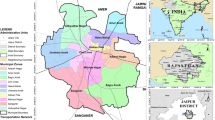Abstract
Before risk assessments for sinkhole damage and indemnification are developed, a data base must be created to predict the occurrence and distribution of sinkholes. This database must be evaluated in terms of the following questions: (1) are available records of modern sinkhole development adequate, (2) can the distribution of ancient sinks be used for predictive purposes, and (3) at what areal scale must sinkhole occurrences be evaluated for predictive and risk analysis purposes?
Twelve 7.5′ quadrangles with varying karst development in Hillsborough County, Florida provide insight into these questions. The area includes 179 modern sinks that developed between 1964 and 1985 and 2,303 ancient sinks. The sinks occur in urban, suburban, agricultural, and major forest wetland areas.
The number of ancient sinks ranges from 0.1 to 3.2/km2 and averages 1.1/km2 for the entire area. The quadrangle area occupied by ancient sinks ranges from 0.3 to 10.2 percent. The distribution of ancient sinkholes within a quadrangle ranges from 0 to over 25 percent of the land surface. In bare karst areas, the sinks are localized along major lineaments, especially at lineament intersections. Where there is covered karst, ancient sinks may be obscured.
Modern sinkholes did not uniformly through time, they ranged from 0 to 29/yr. The regional occurrence rate is 7.6/yr. Most were reported in urban or suburban areas and their locations coincide with the lineament-controlled areas of ancient karst. Moving-average analysis indicates that the distribution of modern sinks is highly localized and ranges from 0 to 1.9/km2.
Chi-square tests show that the distribution of ancient sinks in bare karst areas significantly predicts the locations of modern sinks. In areas of covered karst, the locations of ancient sinkholes do not predict modern sinks.
It appears that risk-assessment models for sinkhole development can use the distribution of ancient sinks where bare karst is present. In covered karst areas, only extensive historical records will suffice. Areas identified as sinkhole prone by moving-average analysis occupy moderate to small, discrete areas, which indicates that sinkhole prediction models can be adjusted to account for local risk. Historical data are necessary to develop and calibrate risk-assessment models, and ancient sinks provide an important means of establishing confidence and continuity in the models. With high-quality data, local risk maps and estimates of sinkhole probability can be developed.
Similar content being viewed by others
References Cited
Beck, B. F., 1984, A computer based inventory of recorded, recent sinkholes in Florida. Orlando, Fla. Sinkhole Res. Inst., Univ. of Central Fla., Rept. No. 84-85-1, 12 p.
Littlefield, J. R., M. A., Culbreth, S. B., Upchurch, and M. T. Stewart, 1984, Relationship of modern sinkhole development to large-scale photolinear features.In B. F. Beck, ed., Sinkholes: Their Geology, Engineering & Environmental Impact, Rotterdam, A. A. Balkema, p. 189–195.
Metcalfe, S. J., and L. E. Hall, 1984, Sinkhole collapse induced by groundwater pumpage for freeze protection irrigation near Dover, Florida, January 1977.In B. F. Beck, ed., Sinkholes: Their Geology, Engineering & Environmental Impact, Rotterdam, A. A., Balkema, p. 29–33.
Parizek, R. R., 1976, On the nature and significance of fracture traces and lineaments in carbonate and other terranes.In V. Yevjevich, ed., Karst Hydrology and Water Resources, Vol. 1, Karst Hydrology, Ft. Collins, CO, Water Resour. Publ., p. 3–108.
Sinclair, W. C., 1982, Sinkhole development resulting from ground-water withdrawal in the Tampa area, Florida: U.S. Geol. Surv., Water-Res. Invest. Report 81-50, 19 p.
Sinclair, W. C., and J. W. Stewart, 1985, Sinkhole type, development, and distribution in Florida.: Fla. Bur. Geology, Map Series No. 110.
Siniclair, W. C., J. W. Stewart, R. L., Knutilla, A. E., Gilboy, and R. L. Miller, 1985, Types, features, and occurrence of sinkholes in the karst of west-central Florida: U.S. Geol. Surv., Water-Res. Invest. Report 85-4126, 81 p.
Upchurch, S. B., and F. W. Lawrence, 1984, Impact of ground-water chemistry on sinkhole development along a retreating scarp.In B. F. Beck, ed., Sinkholes: Their Geology, Engineering & Environmental Impact Rotterdam, A. A. Balkema, p. 23–28.
Wright, A. P., 1973, Environmental geology and hydrology-Tampa area, Florida: Fla. Bur. Geology, Sp. Pub. No. 19, 94 p.
Author information
Authors and Affiliations
Rights and permissions
About this article
Cite this article
Upchurch, S.B., Littlefield, J.R. Evaluation of data for Sinkhole-development risk models. Environ. Geol. Water Sci 12, 135–140 (1988). https://doi.org/10.1007/BF02574800
Issue Date:
DOI: https://doi.org/10.1007/BF02574800




